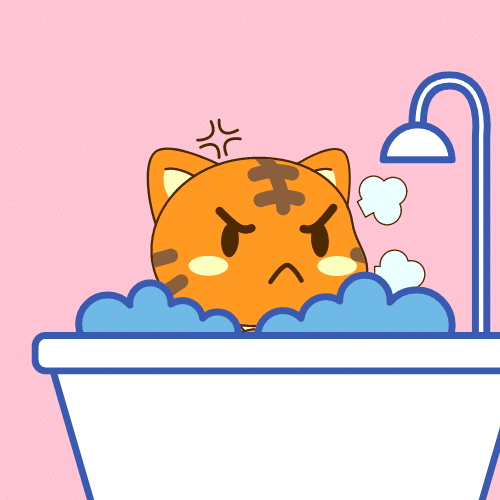Bathing a cat is almost never an enjoyable experience for any party involved in the process. Washing the cats that we typically keep around has the potential to provoke an emotional freakout, which will inevitably result in cat hair being spread all over the place.

There are, however, some useful steps you can take to ensure that bathing a cat in a sink or a bathroom goes well and, as a result, that you and your toilet stay unpolluted after the process.
Should You Bathe Cats
It’s not often that you see cats doing well in the water. And attempting to submerge them in water without doing some research might be traumatic for you and your kitty.
How to Bathe an Aggressive Cat?
Here are some steps (cat bath hacks) that ease your aggressive cat’s whole bathing process.
Step 1
Try to enlist the assistance of another person; ideally someone your cat is familiar with and enjoys. While you are bathing the animal, the other person can assist you by holding the cat.
Step 2
Before you try to bathe your cat, you should first use nail clippers to trim your cat’s nails. The vast majority of cats will make an effort to flee from you; therefore, keeping their claws trimmed can help lessen the number of scratches you experience when they are running away from you.
Step 3
Before you bathe them, use a brush to detangle their fur and remove any mats that may have formed. If there are tough knots, getting rid of them before you bring the cat into the water is best because getting them wet will make them tighter.
Step 4
If you want your cat to have a strong grip on the top of the water in the bathtub, place a towel at the lower surface of the tub and use it as a bathmat.
Step 5
Use minimal water, and the temperature should be kept at 20C-25 C.
Step 6
Before taking your cat into the bathroom, ensure that the bathtub and any additional buckets are entirely full of water. This will ensure that they are not startled by the sound of the running water.
Step 7
Use a shampoo that has been developed especially for use while washing cats. Anything else can be dangerous or even poisonous for your feline friend.
Step 8
Take extreme caution while handling your cat’s head, and be sure to keep water out of his or her eyes, ears, and nose at all costs.
Step 9
After washing your cat with mild soap and a gentle towel, give them a thorough rinsing in warm water to remove any traces of the detergent from their fur. To remove the soap altogether, use the additional buckets of water.
Step 10
While you are bathing your cat, speak to it in a soothing tone of voice. This will assist in maintaining their composure.
Step 11
In order to prevent tangling and mats from forming in your cat’s long fur, you may need to detangle it by combing it while it is still wet.
Step 12
After that, dry them with a clean towel.
In most cases, a healthy adult cat does not need to be bathed. The only exception to this rule is when the cat has gotten into anything that has covered the fur and cannot be easily removed by brushing. Cats have a natural tendency to clean themselves, but their owners may assist in keeping them tidy by cleaning or combing their fur regularly.
How to Prepare a Bathroom for Pet Bathe
Here is how you can prepare your bathroom for your cat’s bath.

Pet Shower Enclosures
There are pet-friendly shower enclosures available in the market that can be customized to match any bathroom space, regardless of its dimensions. One of the most convenient methods to clean your pet is to use a walk-in shower since it eliminates the need to hoist them into the bathtub. Wet rooms are yet another alternative that offers ample space for you and your dogs to enjoy together.
Pet-Friendly Flooring
After bathing your cats, the flooring in your bathroom will be considerably easier to clean if you have tile, hardwood, or vinyl flooring. After being washed, pets may benefit from walking on non-slip flooring, reducing the likelihood of falling and hurting themselves. The comfort of your dogs during the washing process can also be improved by using non-slip shower rugs or bath mats.
Water Heater Facilities
Even though taking a hot shower is more enjoyable for humans, the best temperature for bathing cats is tepid water since really hot water can lead to injuries or skin irritation.
Good Drainage System
Ensure the availability of a good drainage system. It is because there are a lot of cats whose hair fell down in huge quantities during washing. So, a proper drainage system is necessary to remove these hairs and other contaminants.
- How to Reuse Crystal Cat Litter?
- Newly Adopted Cat Not Eating [Reasons]
- Cat Disappeared Without a Trace [Guide]
- How to Keep Possums Away From Cat Food?
FAQs
Question: How Do You Calm a Stressed Cat in a Bath?
Answer: You can calm an aggressive kitty during bathing by offering treats, such as licks of salmon or soft kitty food.

Question: Can I Sedate My Cat to Bathe Him?
Answer: Bathing a cat may need the use of a sedative at the veterinarian clinic in some cases. But remember, before any kind of anesthesia was administered, a checkup on their health would be done. If your cat has difficulty accepting being groomed or washed, this is a less stressful alternative than bathing them forcefully at home.
Question: How Often Should You Bathe Your Cat?
Answer: In general, kitties should be bathed once every five to six weeks, although this frequency might vary depending on how frequently they brush themselves and the environment in which they spend most of their time.
Verdict
Bathing a cat may be quite stressful for them, which can lead to them screaming, lifting their fur, or even attacking you. Because of this, cats are far more prone to become protective or even violent after being bathed. However, with enough planning and perseverance, you can shower your cat without getting scratched.

Veterinarian (DVM, MS) Content Writer, Blogger, and WordPress Developer. Working as a pet/animal/bird/fish/reptile/wildlife writer for the past 7 years on many renowned platforms.




